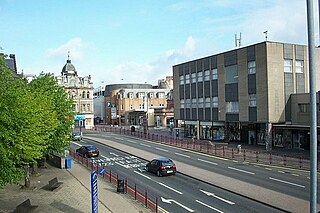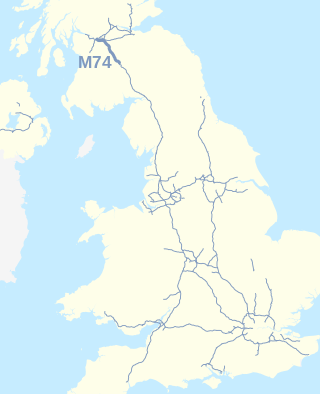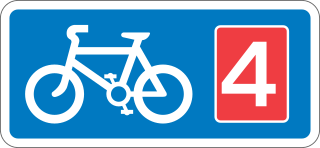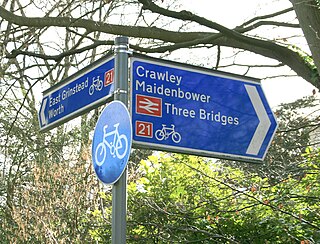This article needs additional citations for verification .(August 2016) |
National Cycle Route 74 is a mostly complete (other than a few metres) route between Gretna and Glasgow.
This article needs additional citations for verification .(August 2016) |
National Cycle Route 74 is a mostly complete (other than a few metres) route between Gretna and Glasgow.
Route 74 begins, branching off from Route 7, a couple of kilometers west of Gretna. (National Route 7 connects Carlisle to Gretna - around 14km north as the crow flies.)
For much of its length National Route 74 follows the main transport corridor north of Gretna - sharing the general area with the main motorway and West Coast Main Line. North of Abington the railway chooses a different route (via Carstairs Junction), and then north of Lesmahagow and Blackwood the number of urban settlements increases.
From the Hamilton area onward the route is navigating the Greater Glasgow conurbation - marking out a quieter route north-south, touching on Motherwell, and passing through Bothwell and Uddingston, where it ends (joining National Route 75).
Travel into central Glasgow can be achieved on National Route 75. If you turn the other way it'll take you to Edinburgh, although that's a longer trip).
One of the interesting features of this route is the re-purposed south-bound lane of the former dual carriageway B7078 (which was the A74)
The one remaining incomplete section lies just north of Lesmahagow, comprising two road roundabouts and a flyover over the M74. It is possible to negotiate the area on foot, or by cycling on the road to join the next stage of the route.

Hamilton is a large town in South Lanarkshire, Scotland. It serves as the main administrative centre of the South Lanarkshire council area. It sits 10 miles (16 km) south-east of Glasgow, 37 miles (60 km) south-west of Edinburgh and 74 miles (120 km) north of Carlisle. It is situated on the south bank of the River Clyde at its confluence with the Avon Water. Hamilton is the county town of the historic county of Lanarkshire and is the location of the headquarters of the modern local authority of South Lanarkshire.

Dumfries and Galloway is one of 32 unitary council areas of Scotland and is located in the western Southern Uplands. It covers the historic counties of Dumfriesshire, Kirkcudbrightshire, and Wigtownshire, the latter two of which are collectively known as Galloway. The administrative centre and largest settlement is the town of Dumfries. The second largest town is Stranraer, on the North Channel coast, some 57 miles (92 km) to the west of Dumfries.

The A74(M) and M74 form a major motorway in Scotland, connecting it to England. The routes connect the M8 motorway in central Glasgow to the Scottish-English border at Gretna. In conjunction with their southward continuation, the M6 motorway, they form one of the three major cross-border routes between Scotland and England. They are part of the unsigned international E-road network E05. Although the entire route is colloquially referred to as the M74, for more than half its length, south of Abington, the road is officially the A74(M); see naming confusion below.

The National Cycle Network (NCN) is the national cycling route network of the United Kingdom, which was established to encourage cycling and walking throughout Britain, as well as for the purposes of bicycle touring. It was created by the charity Sustrans who were aided by a £42.5 million National Lottery grant. However Sustrans themselves only own around 2% of the paths on the network, these rest being made of existing public highways and rights of way, and permissive paths negotiated by Sustrans with private landowners, which Sustrans have then labelled as part of their network.

The A74 also known historically as the Glasgow to Carlisle Road, is a formerly major road in the United Kingdom, linking Glasgow in Scotland to Carlisle in the North West of England, passing through Clydesdale, Annandale and the Southern Uplands. A road in this area has existed since Roman Britain, and it was considered one of the most important roads in Scotland, being used as a regular mail service route.
Enfield Lock is an area in the London Borough of Enfield, north London. It is approximately located east of the Hertford Road between Turkey Street and the Holmesdale Tunnel overpass, and extends to the River Lee Navigation, including the Enfield Island Village. The locality gains its name from the lock on the River Lee Navigation. Today's Enfield Lock was rebuilt in 1922. The area forms part of the Lee Valley Park and the Enfield Lock Conservation Area. On its eastern boundary Enfield Lock has marshland formerly used as a testing site between the Royal Small Arms Factory and the Gunpowder Mills, beyond this is the village of Sewardstone and the Epping forest boundary. To the south is Brimsdown, the north Waltham Cross and to the west Bullsmoor and Freezywater. Enfield Lock forms part of the London boundary.

National Cycle Route 4 is a route of the National Cycle Network, running from London to Fishguard, Pembrokeshire. Between these, the route runs through Reading, Bath, Bristol, Newport, Swansea and St David's. Within Wales, sections of the route follow branches of the Celtic Trail cycle route.

National Cycle Route 1 is a route of the National Cycle Network, running from Dover to Tain. The 1,264 mi-long (2,034-kilometre) cycle-path is located in the United Kingdom.
National Cycle Route 6 is a route of the National Cycle Network, running from London to the Lake District.
National Cycle Route 7 is a route of the National Cycle Network, running from Sunderland to Inverness.
The National Cycle Route 13 is a cycling route that is part of the National Cycle Network in the United Kingdom. It connects Tower Bridge in London with Fakenham in Norwich.
National Cycle Route 75 runs from Edinburgh to Gourock via Glasgow. It is often known as the Clyde to Forth cycle route.
National Cycle Route 78 runs from Campbeltown to Inverness. It was officially launched as the Caledonia Way in 2016 as part of the wider redevelopment of Scotland's cycle network. It runs from the Kintyre peninsula to the Great Glen and the route varies from on road to traffic-free forest trails and canal paths.
National Cycle Route 23 is a route of the National Cycle Network, running from Reading to Sandown. The partially signed route passes through Basingstoke, Eastleigh and Southampton; once across the Solent, it continues through Cowes and Newport.

National Cycle Route 21 is part of the United Kingdom's National Cycle Network. It runs from Greenwich in South-East London south to Crawley, then east to Groombridge and south to Eastbourne, with a short final loop northwards again to its end at Pevensey.
NCR 756 is a National Cycle route in Glasgow and South Lanarkshire that runs eight miles from Kelvindale to East Kilbride. It opened in 2009 following four years of construction.

National Cycle Route 57 is part of the United Kingdom's National Cycle Network. When complete, it will run west to east from Farmington, Gloucestershire near Northleach to Welwyn Garden City in Hertfordshire.
This article traces the Caledonian Railway branches in South Lanarkshire.

National Cycle Route 88 is a route of the National Cycle Network, running from Newport to its planned finish site at Margam.

The A724 road in Scotland runs within South Lanarkshire between Rutherglen and Hamilton. It follows an ancient route which is marked on William Roy's Lowland Map of Scotland (1755) with only minor deviations from its modern course.